HI6028 Taxation Law: Capital Gains, Income, and Loan Repayments
VerifiedAdded on 2023/03/31
|8
|2113
|456
Homework Assignment
AI Summary
This assignment delves into various aspects of Australian taxation law, focusing on capital gains tax (CGT) implications related to the sale of collectibles, the determination of assessable income from personal exertion, and the tax treatment of loan repayments. The first question analyzes CGT events triggered by the sale of antique paintings and historical structures, considering cost base calculations and potential discounts. The second question examines whether receipts earned by an independent contractor, Barbara, for writing books and selling manuscripts constitute assessable income, referencing relevant case laws and taxation rulings. Finally, the third question addresses whether additional repayments on a loan, structured as a percentage of the original amount, should be considered assessable income for the recipient. The assignment applies relevant sections of the ITAA 1997 and ITAA 1936, alongside case law, to provide a comprehensive analysis of each scenario. Desklib offers similar solved assignments and study resources for students.
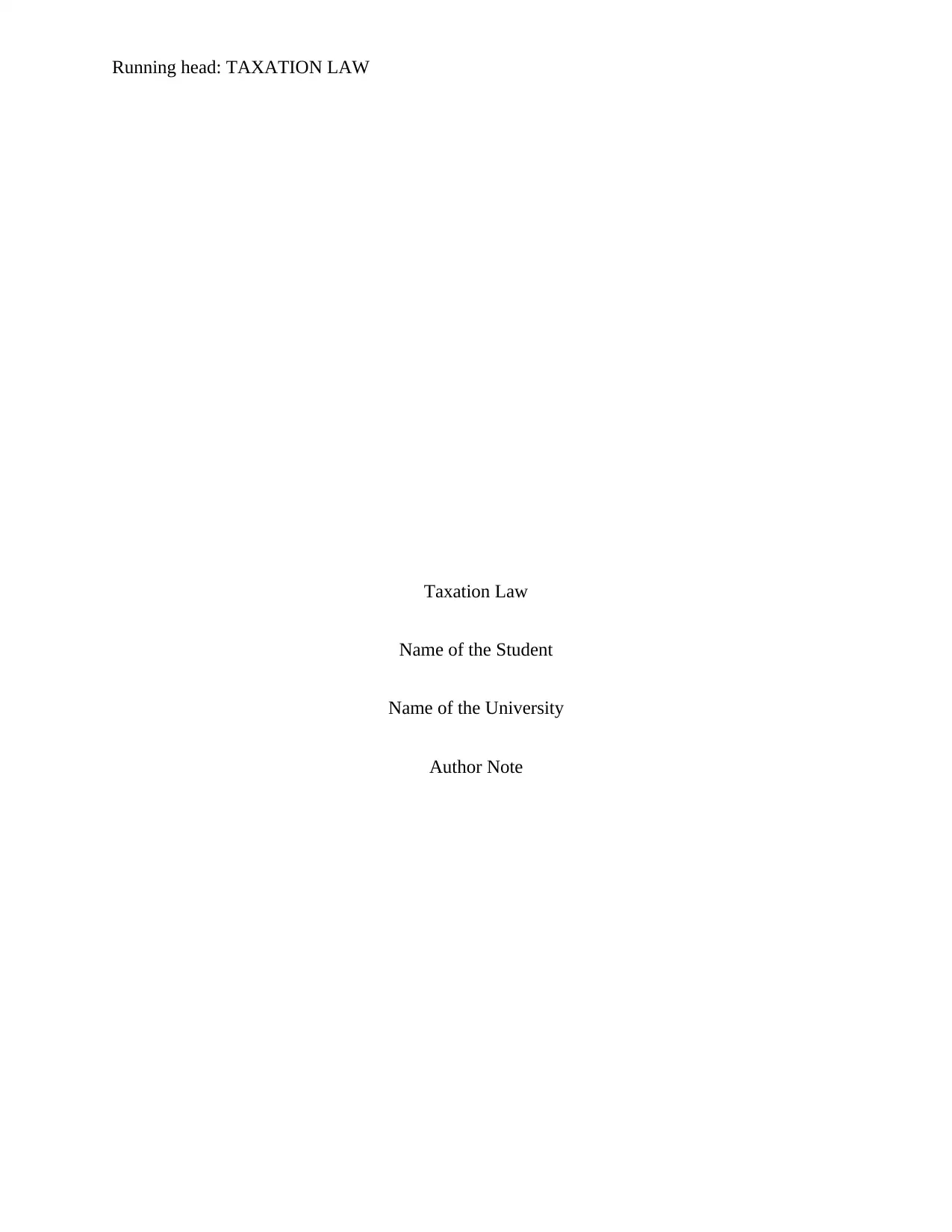
Running head: TAXATION LAW
Taxation Law
Name of the Student
Name of the University
Author Note
Taxation Law
Name of the Student
Name of the University
Author Note
Paraphrase This Document
Need a fresh take? Get an instant paraphrase of this document with our AI Paraphraser
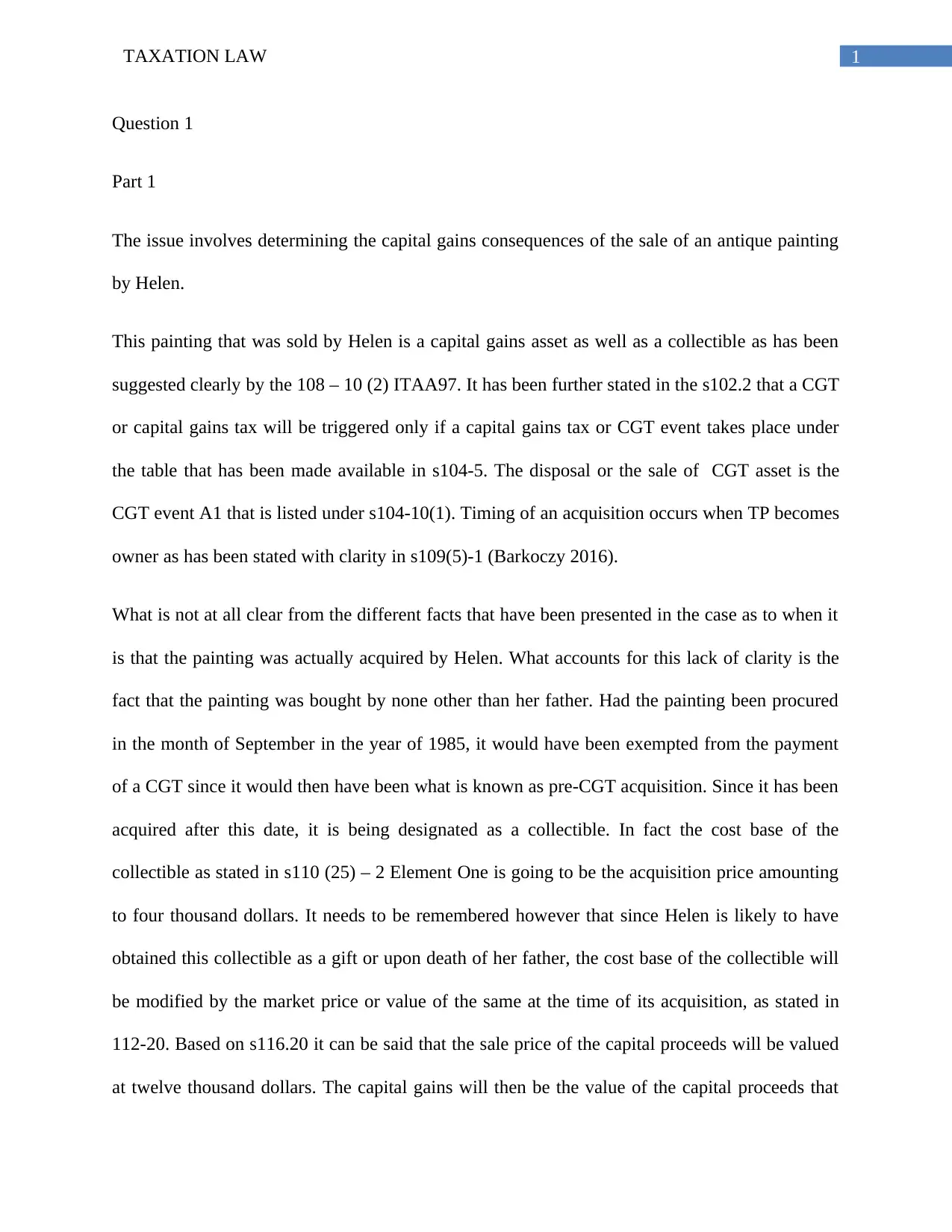
1TAXATION LAW
Question 1
Part 1
The issue involves determining the capital gains consequences of the sale of an antique painting
by Helen.
This painting that was sold by Helen is a capital gains asset as well as a collectible as has been
suggested clearly by the 108 – 10 (2) ITAA97. It has been further stated in the s102.2 that a CGT
or capital gains tax will be triggered only if a capital gains tax or CGT event takes place under
the table that has been made available in s104-5. The disposal or the sale of CGT asset is the
CGT event A1 that is listed under s104-10(1). Timing of an acquisition occurs when TP becomes
owner as has been stated with clarity in s109(5)-1 (Barkoczy 2016).
What is not at all clear from the different facts that have been presented in the case as to when it
is that the painting was actually acquired by Helen. What accounts for this lack of clarity is the
fact that the painting was bought by none other than her father. Had the painting been procured
in the month of September in the year of 1985, it would have been exempted from the payment
of a CGT since it would then have been what is known as pre-CGT acquisition. Since it has been
acquired after this date, it is being designated as a collectible. In fact the cost base of the
collectible as stated in s110 (25) – 2 Element One is going to be the acquisition price amounting
to four thousand dollars. It needs to be remembered however that since Helen is likely to have
obtained this collectible as a gift or upon death of her father, the cost base of the collectible will
be modified by the market price or value of the same at the time of its acquisition, as stated in
112-20. Based on s116.20 it can be said that the sale price of the capital proceeds will be valued
at twelve thousand dollars. The capital gains will then be the value of the capital proceeds that
Question 1
Part 1
The issue involves determining the capital gains consequences of the sale of an antique painting
by Helen.
This painting that was sold by Helen is a capital gains asset as well as a collectible as has been
suggested clearly by the 108 – 10 (2) ITAA97. It has been further stated in the s102.2 that a CGT
or capital gains tax will be triggered only if a capital gains tax or CGT event takes place under
the table that has been made available in s104-5. The disposal or the sale of CGT asset is the
CGT event A1 that is listed under s104-10(1). Timing of an acquisition occurs when TP becomes
owner as has been stated with clarity in s109(5)-1 (Barkoczy 2016).
What is not at all clear from the different facts that have been presented in the case as to when it
is that the painting was actually acquired by Helen. What accounts for this lack of clarity is the
fact that the painting was bought by none other than her father. Had the painting been procured
in the month of September in the year of 1985, it would have been exempted from the payment
of a CGT since it would then have been what is known as pre-CGT acquisition. Since it has been
acquired after this date, it is being designated as a collectible. In fact the cost base of the
collectible as stated in s110 (25) – 2 Element One is going to be the acquisition price amounting
to four thousand dollars. It needs to be remembered however that since Helen is likely to have
obtained this collectible as a gift or upon death of her father, the cost base of the collectible will
be modified by the market price or value of the same at the time of its acquisition, as stated in
112-20. Based on s116.20 it can be said that the sale price of the capital proceeds will be valued
at twelve thousand dollars. The capital gains will then be the value of the capital proceeds that
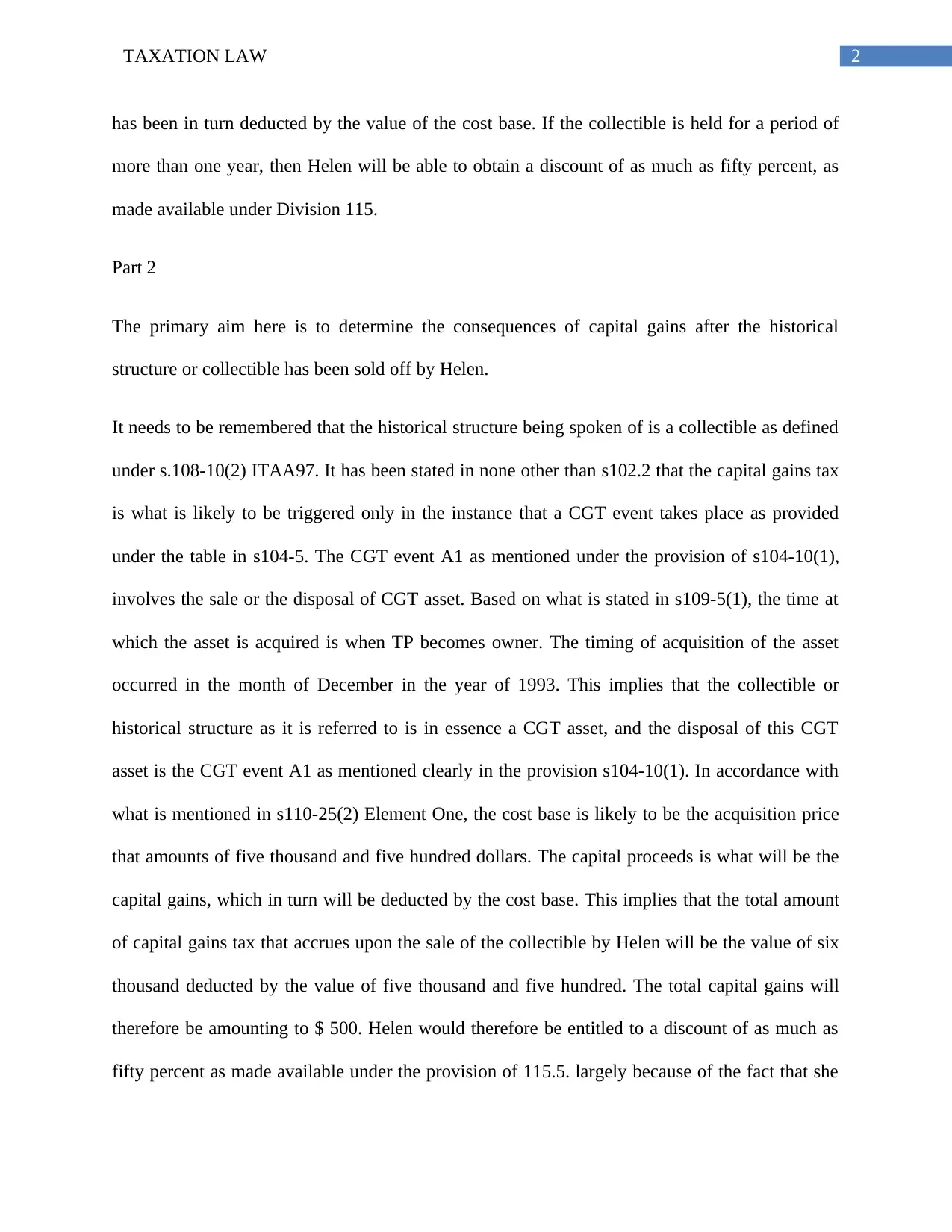
2TAXATION LAW
has been in turn deducted by the value of the cost base. If the collectible is held for a period of
more than one year, then Helen will be able to obtain a discount of as much as fifty percent, as
made available under Division 115.
Part 2
The primary aim here is to determine the consequences of capital gains after the historical
structure or collectible has been sold off by Helen.
It needs to be remembered that the historical structure being spoken of is a collectible as defined
under s.108-10(2) ITAA97. It has been stated in none other than s102.2 that the capital gains tax
is what is likely to be triggered only in the instance that a CGT event takes place as provided
under the table in s104-5. The CGT event A1 as mentioned under the provision of s104-10(1),
involves the sale or the disposal of CGT asset. Based on what is stated in s109-5(1), the time at
which the asset is acquired is when TP becomes owner. The timing of acquisition of the asset
occurred in the month of December in the year of 1993. This implies that the collectible or
historical structure as it is referred to is in essence a CGT asset, and the disposal of this CGT
asset is the CGT event A1 as mentioned clearly in the provision s104-10(1). In accordance with
what is mentioned in s110-25(2) Element One, the cost base is likely to be the acquisition price
that amounts of five thousand and five hundred dollars. The capital proceeds is what will be the
capital gains, which in turn will be deducted by the cost base. This implies that the total amount
of capital gains tax that accrues upon the sale of the collectible by Helen will be the value of six
thousand deducted by the value of five thousand and five hundred. The total capital gains will
therefore be amounting to $ 500. Helen would therefore be entitled to a discount of as much as
fifty percent as made available under the provision of 115.5. largely because of the fact that she
has been in turn deducted by the value of the cost base. If the collectible is held for a period of
more than one year, then Helen will be able to obtain a discount of as much as fifty percent, as
made available under Division 115.
Part 2
The primary aim here is to determine the consequences of capital gains after the historical
structure or collectible has been sold off by Helen.
It needs to be remembered that the historical structure being spoken of is a collectible as defined
under s.108-10(2) ITAA97. It has been stated in none other than s102.2 that the capital gains tax
is what is likely to be triggered only in the instance that a CGT event takes place as provided
under the table in s104-5. The CGT event A1 as mentioned under the provision of s104-10(1),
involves the sale or the disposal of CGT asset. Based on what is stated in s109-5(1), the time at
which the asset is acquired is when TP becomes owner. The timing of acquisition of the asset
occurred in the month of December in the year of 1993. This implies that the collectible or
historical structure as it is referred to is in essence a CGT asset, and the disposal of this CGT
asset is the CGT event A1 as mentioned clearly in the provision s104-10(1). In accordance with
what is mentioned in s110-25(2) Element One, the cost base is likely to be the acquisition price
that amounts of five thousand and five hundred dollars. The capital proceeds is what will be the
capital gains, which in turn will be deducted by the cost base. This implies that the total amount
of capital gains tax that accrues upon the sale of the collectible by Helen will be the value of six
thousand deducted by the value of five thousand and five hundred. The total capital gains will
therefore be amounting to $ 500. Helen would therefore be entitled to a discount of as much as
fifty percent as made available under the provision of 115.5. largely because of the fact that she
⊘ This is a preview!⊘
Do you want full access?
Subscribe today to unlock all pages.

Trusted by 1+ million students worldwide
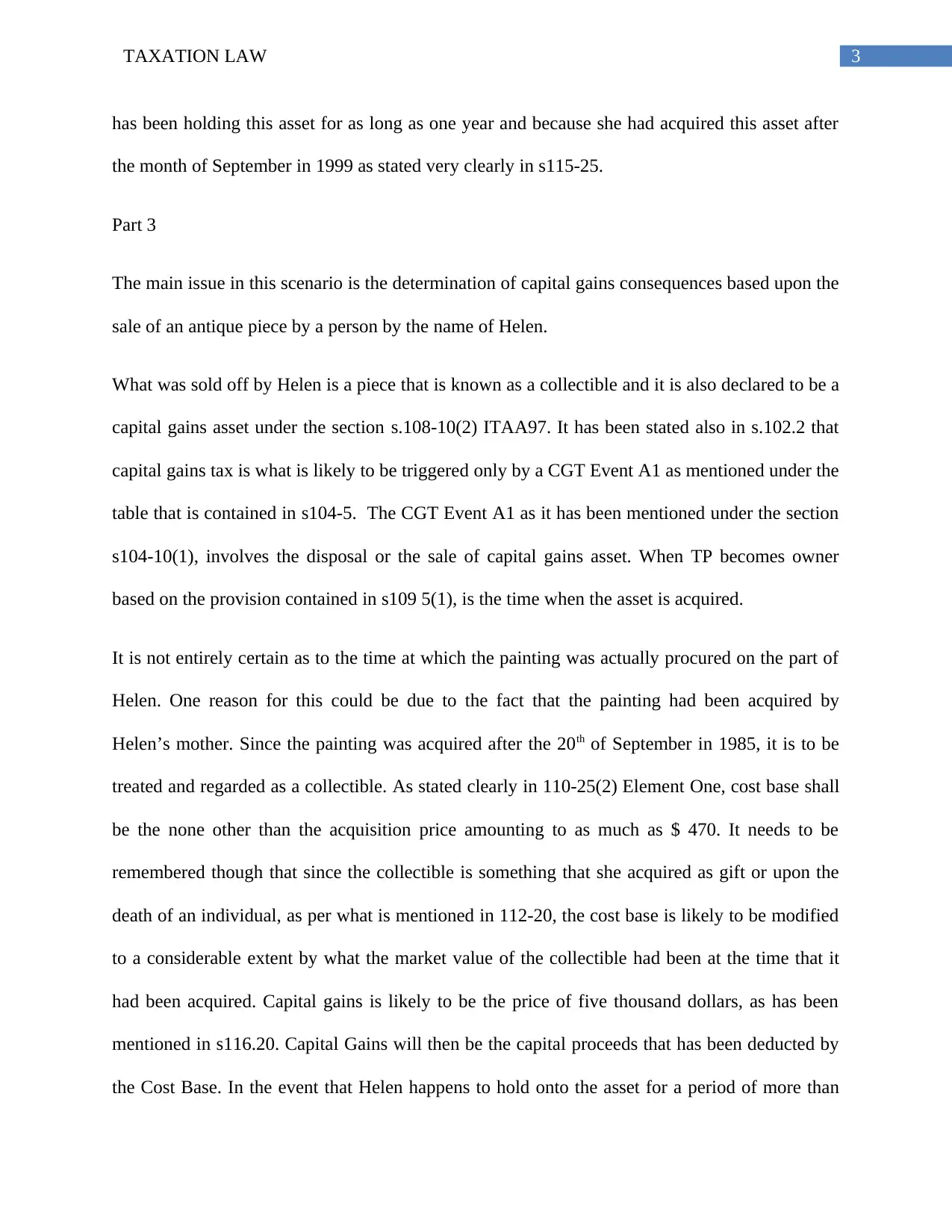
3TAXATION LAW
has been holding this asset for as long as one year and because she had acquired this asset after
the month of September in 1999 as stated very clearly in s115-25.
Part 3
The main issue in this scenario is the determination of capital gains consequences based upon the
sale of an antique piece by a person by the name of Helen.
What was sold off by Helen is a piece that is known as a collectible and it is also declared to be a
capital gains asset under the section s.108-10(2) ITAA97. It has been stated also in s.102.2 that
capital gains tax is what is likely to be triggered only by a CGT Event A1 as mentioned under the
table that is contained in s104-5. The CGT Event A1 as it has been mentioned under the section
s104-10(1), involves the disposal or the sale of capital gains asset. When TP becomes owner
based on the provision contained in s109 5(1), is the time when the asset is acquired.
It is not entirely certain as to the time at which the painting was actually procured on the part of
Helen. One reason for this could be due to the fact that the painting had been acquired by
Helen’s mother. Since the painting was acquired after the 20th of September in 1985, it is to be
treated and regarded as a collectible. As stated clearly in 110-25(2) Element One, cost base shall
be the none other than the acquisition price amounting to as much as $ 470. It needs to be
remembered though that since the collectible is something that she acquired as gift or upon the
death of an individual, as per what is mentioned in 112-20, the cost base is likely to be modified
to a considerable extent by what the market value of the collectible had been at the time that it
had been acquired. Capital gains is likely to be the price of five thousand dollars, as has been
mentioned in s116.20. Capital Gains will then be the capital proceeds that has been deducted by
the Cost Base. In the event that Helen happens to hold onto the asset for a period of more than
has been holding this asset for as long as one year and because she had acquired this asset after
the month of September in 1999 as stated very clearly in s115-25.
Part 3
The main issue in this scenario is the determination of capital gains consequences based upon the
sale of an antique piece by a person by the name of Helen.
What was sold off by Helen is a piece that is known as a collectible and it is also declared to be a
capital gains asset under the section s.108-10(2) ITAA97. It has been stated also in s.102.2 that
capital gains tax is what is likely to be triggered only by a CGT Event A1 as mentioned under the
table that is contained in s104-5. The CGT Event A1 as it has been mentioned under the section
s104-10(1), involves the disposal or the sale of capital gains asset. When TP becomes owner
based on the provision contained in s109 5(1), is the time when the asset is acquired.
It is not entirely certain as to the time at which the painting was actually procured on the part of
Helen. One reason for this could be due to the fact that the painting had been acquired by
Helen’s mother. Since the painting was acquired after the 20th of September in 1985, it is to be
treated and regarded as a collectible. As stated clearly in 110-25(2) Element One, cost base shall
be the none other than the acquisition price amounting to as much as $ 470. It needs to be
remembered though that since the collectible is something that she acquired as gift or upon the
death of an individual, as per what is mentioned in 112-20, the cost base is likely to be modified
to a considerable extent by what the market value of the collectible had been at the time that it
had been acquired. Capital gains is likely to be the price of five thousand dollars, as has been
mentioned in s116.20. Capital Gains will then be the capital proceeds that has been deducted by
the Cost Base. In the event that Helen happens to hold onto the asset for a period of more than
Paraphrase This Document
Need a fresh take? Get an instant paraphrase of this document with our AI Paraphraser
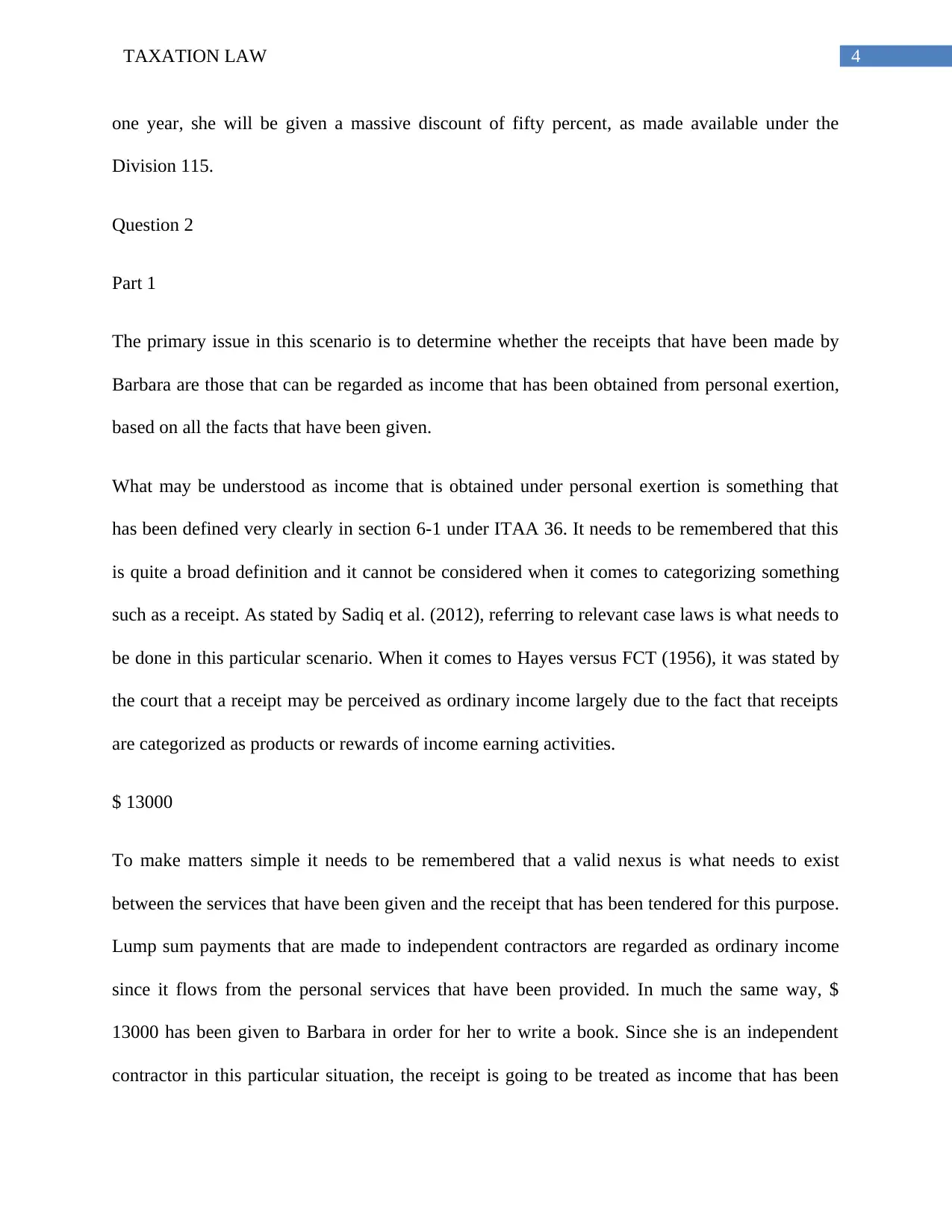
4TAXATION LAW
one year, she will be given a massive discount of fifty percent, as made available under the
Division 115.
Question 2
Part 1
The primary issue in this scenario is to determine whether the receipts that have been made by
Barbara are those that can be regarded as income that has been obtained from personal exertion,
based on all the facts that have been given.
What may be understood as income that is obtained under personal exertion is something that
has been defined very clearly in section 6-1 under ITAA 36. It needs to be remembered that this
is quite a broad definition and it cannot be considered when it comes to categorizing something
such as a receipt. As stated by Sadiq et al. (2012), referring to relevant case laws is what needs to
be done in this particular scenario. When it comes to Hayes versus FCT (1956), it was stated by
the court that a receipt may be perceived as ordinary income largely due to the fact that receipts
are categorized as products or rewards of income earning activities.
$ 13000
To make matters simple it needs to be remembered that a valid nexus is what needs to exist
between the services that have been given and the receipt that has been tendered for this purpose.
Lump sum payments that are made to independent contractors are regarded as ordinary income
since it flows from the personal services that have been provided. In much the same way, $
13000 has been given to Barbara in order for her to write a book. Since she is an independent
contractor in this particular situation, the receipt is going to be treated as income that has been
one year, she will be given a massive discount of fifty percent, as made available under the
Division 115.
Question 2
Part 1
The primary issue in this scenario is to determine whether the receipts that have been made by
Barbara are those that can be regarded as income that has been obtained from personal exertion,
based on all the facts that have been given.
What may be understood as income that is obtained under personal exertion is something that
has been defined very clearly in section 6-1 under ITAA 36. It needs to be remembered that this
is quite a broad definition and it cannot be considered when it comes to categorizing something
such as a receipt. As stated by Sadiq et al. (2012), referring to relevant case laws is what needs to
be done in this particular scenario. When it comes to Hayes versus FCT (1956), it was stated by
the court that a receipt may be perceived as ordinary income largely due to the fact that receipts
are categorized as products or rewards of income earning activities.
$ 13000
To make matters simple it needs to be remembered that a valid nexus is what needs to exist
between the services that have been given and the receipt that has been tendered for this purpose.
Lump sum payments that are made to independent contractors are regarded as ordinary income
since it flows from the personal services that have been provided. In much the same way, $
13000 has been given to Barbara in order for her to write a book. Since she is an independent
contractor in this particular situation, the receipt is going to be treated as income that has been
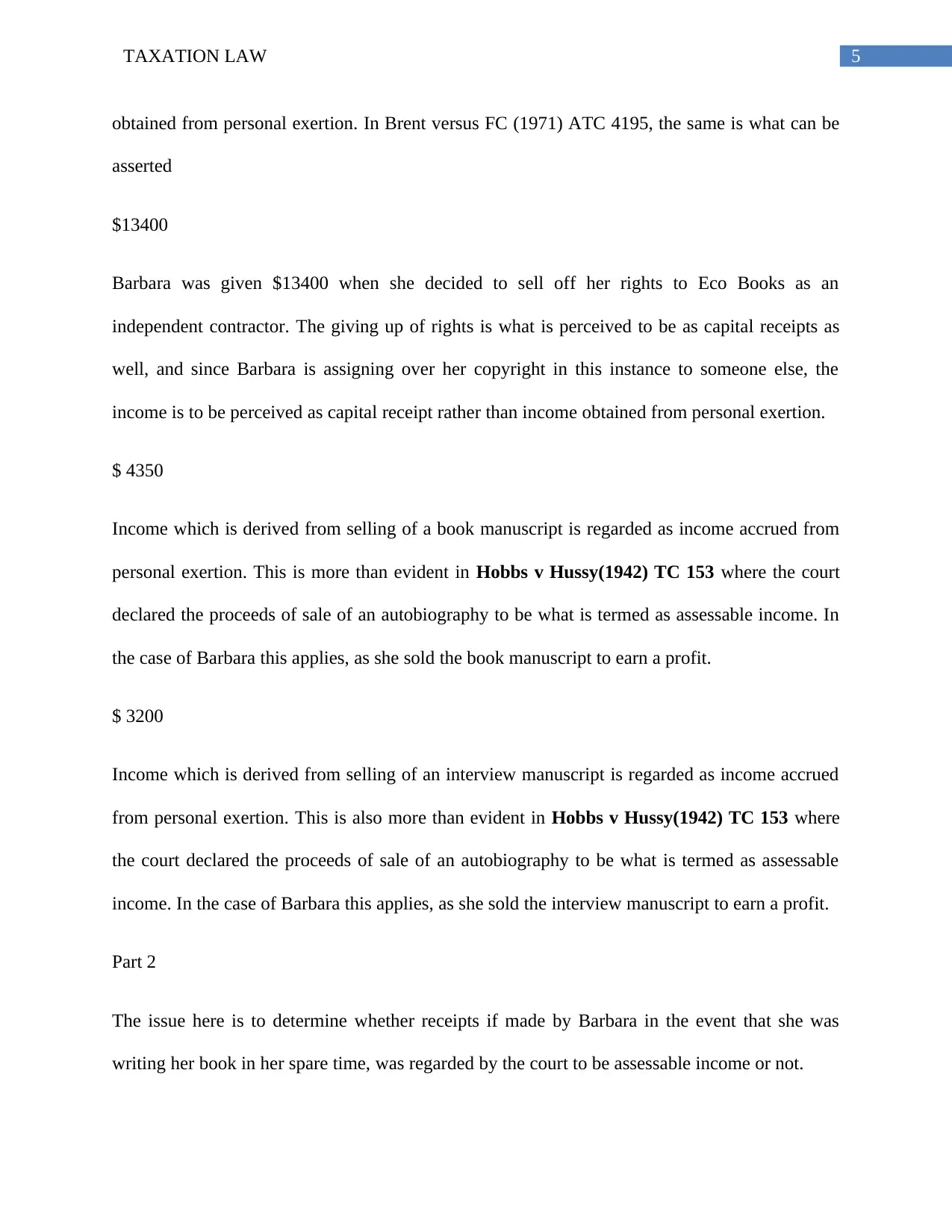
5TAXATION LAW
obtained from personal exertion. In Brent versus FC (1971) ATC 4195, the same is what can be
asserted
$13400
Barbara was given $13400 when she decided to sell off her rights to Eco Books as an
independent contractor. The giving up of rights is what is perceived to be as capital receipts as
well, and since Barbara is assigning over her copyright in this instance to someone else, the
income is to be perceived as capital receipt rather than income obtained from personal exertion.
$ 4350
Income which is derived from selling of a book manuscript is regarded as income accrued from
personal exertion. This is more than evident in Hobbs v Hussy(1942) TC 153 where the court
declared the proceeds of sale of an autobiography to be what is termed as assessable income. In
the case of Barbara this applies, as she sold the book manuscript to earn a profit.
$ 3200
Income which is derived from selling of an interview manuscript is regarded as income accrued
from personal exertion. This is also more than evident in Hobbs v Hussy(1942) TC 153 where
the court declared the proceeds of sale of an autobiography to be what is termed as assessable
income. In the case of Barbara this applies, as she sold the interview manuscript to earn a profit.
Part 2
The issue here is to determine whether receipts if made by Barbara in the event that she was
writing her book in her spare time, was regarded by the court to be assessable income or not.
obtained from personal exertion. In Brent versus FC (1971) ATC 4195, the same is what can be
asserted
$13400
Barbara was given $13400 when she decided to sell off her rights to Eco Books as an
independent contractor. The giving up of rights is what is perceived to be as capital receipts as
well, and since Barbara is assigning over her copyright in this instance to someone else, the
income is to be perceived as capital receipt rather than income obtained from personal exertion.
$ 4350
Income which is derived from selling of a book manuscript is regarded as income accrued from
personal exertion. This is more than evident in Hobbs v Hussy(1942) TC 153 where the court
declared the proceeds of sale of an autobiography to be what is termed as assessable income. In
the case of Barbara this applies, as she sold the book manuscript to earn a profit.
$ 3200
Income which is derived from selling of an interview manuscript is regarded as income accrued
from personal exertion. This is also more than evident in Hobbs v Hussy(1942) TC 153 where
the court declared the proceeds of sale of an autobiography to be what is termed as assessable
income. In the case of Barbara this applies, as she sold the interview manuscript to earn a profit.
Part 2
The issue here is to determine whether receipts if made by Barbara in the event that she was
writing her book in her spare time, was regarded by the court to be assessable income or not.
⊘ This is a preview!⊘
Do you want full access?
Subscribe today to unlock all pages.

Trusted by 1+ million students worldwide
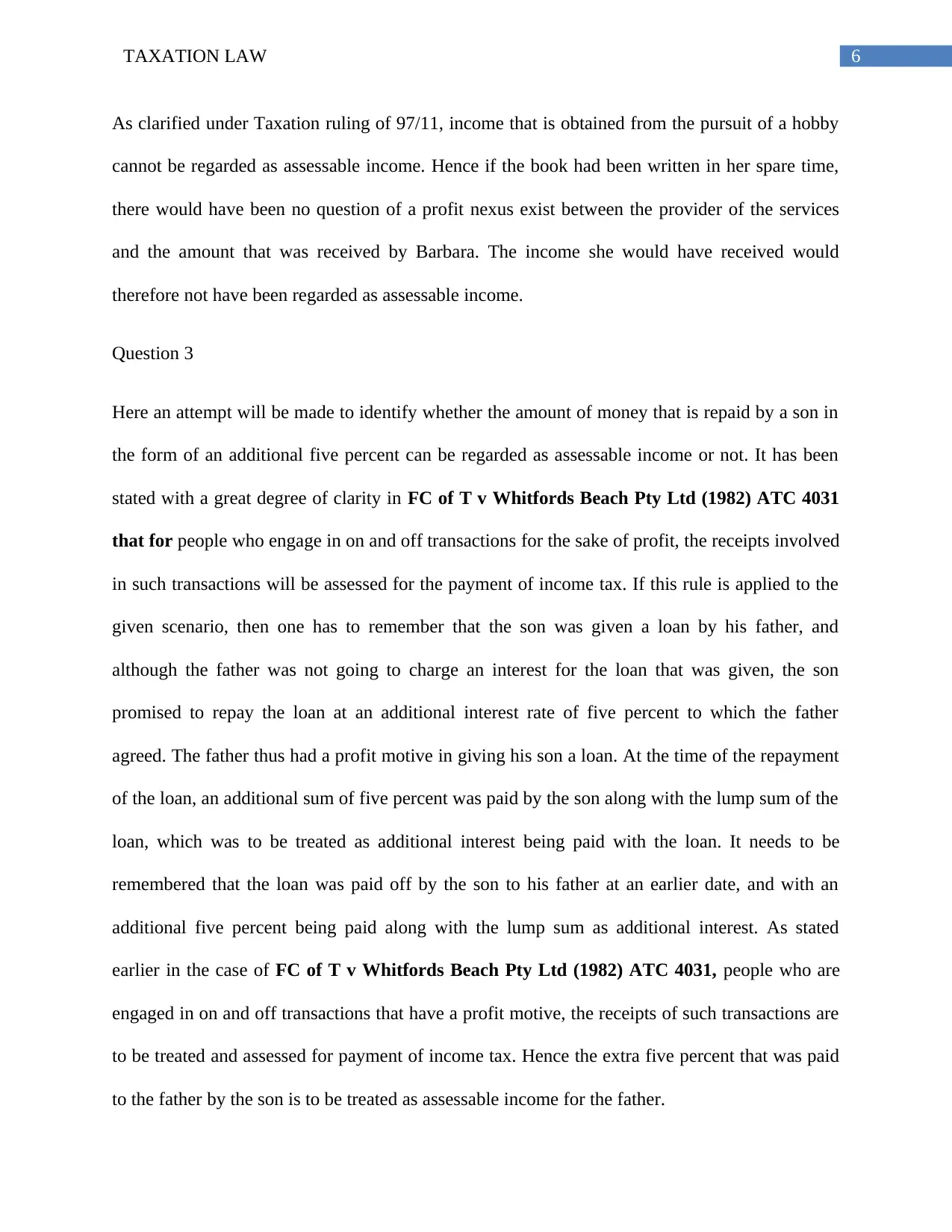
6TAXATION LAW
As clarified under Taxation ruling of 97/11, income that is obtained from the pursuit of a hobby
cannot be regarded as assessable income. Hence if the book had been written in her spare time,
there would have been no question of a profit nexus exist between the provider of the services
and the amount that was received by Barbara. The income she would have received would
therefore not have been regarded as assessable income.
Question 3
Here an attempt will be made to identify whether the amount of money that is repaid by a son in
the form of an additional five percent can be regarded as assessable income or not. It has been
stated with a great degree of clarity in FC of T v Whitfords Beach Pty Ltd (1982) ATC 4031
that for people who engage in on and off transactions for the sake of profit, the receipts involved
in such transactions will be assessed for the payment of income tax. If this rule is applied to the
given scenario, then one has to remember that the son was given a loan by his father, and
although the father was not going to charge an interest for the loan that was given, the son
promised to repay the loan at an additional interest rate of five percent to which the father
agreed. The father thus had a profit motive in giving his son a loan. At the time of the repayment
of the loan, an additional sum of five percent was paid by the son along with the lump sum of the
loan, which was to be treated as additional interest being paid with the loan. It needs to be
remembered that the loan was paid off by the son to his father at an earlier date, and with an
additional five percent being paid along with the lump sum as additional interest. As stated
earlier in the case of FC of T v Whitfords Beach Pty Ltd (1982) ATC 4031, people who are
engaged in on and off transactions that have a profit motive, the receipts of such transactions are
to be treated and assessed for payment of income tax. Hence the extra five percent that was paid
to the father by the son is to be treated as assessable income for the father.
As clarified under Taxation ruling of 97/11, income that is obtained from the pursuit of a hobby
cannot be regarded as assessable income. Hence if the book had been written in her spare time,
there would have been no question of a profit nexus exist between the provider of the services
and the amount that was received by Barbara. The income she would have received would
therefore not have been regarded as assessable income.
Question 3
Here an attempt will be made to identify whether the amount of money that is repaid by a son in
the form of an additional five percent can be regarded as assessable income or not. It has been
stated with a great degree of clarity in FC of T v Whitfords Beach Pty Ltd (1982) ATC 4031
that for people who engage in on and off transactions for the sake of profit, the receipts involved
in such transactions will be assessed for the payment of income tax. If this rule is applied to the
given scenario, then one has to remember that the son was given a loan by his father, and
although the father was not going to charge an interest for the loan that was given, the son
promised to repay the loan at an additional interest rate of five percent to which the father
agreed. The father thus had a profit motive in giving his son a loan. At the time of the repayment
of the loan, an additional sum of five percent was paid by the son along with the lump sum of the
loan, which was to be treated as additional interest being paid with the loan. It needs to be
remembered that the loan was paid off by the son to his father at an earlier date, and with an
additional five percent being paid along with the lump sum as additional interest. As stated
earlier in the case of FC of T v Whitfords Beach Pty Ltd (1982) ATC 4031, people who are
engaged in on and off transactions that have a profit motive, the receipts of such transactions are
to be treated and assessed for payment of income tax. Hence the extra five percent that was paid
to the father by the son is to be treated as assessable income for the father.
Paraphrase This Document
Need a fresh take? Get an instant paraphrase of this document with our AI Paraphraser
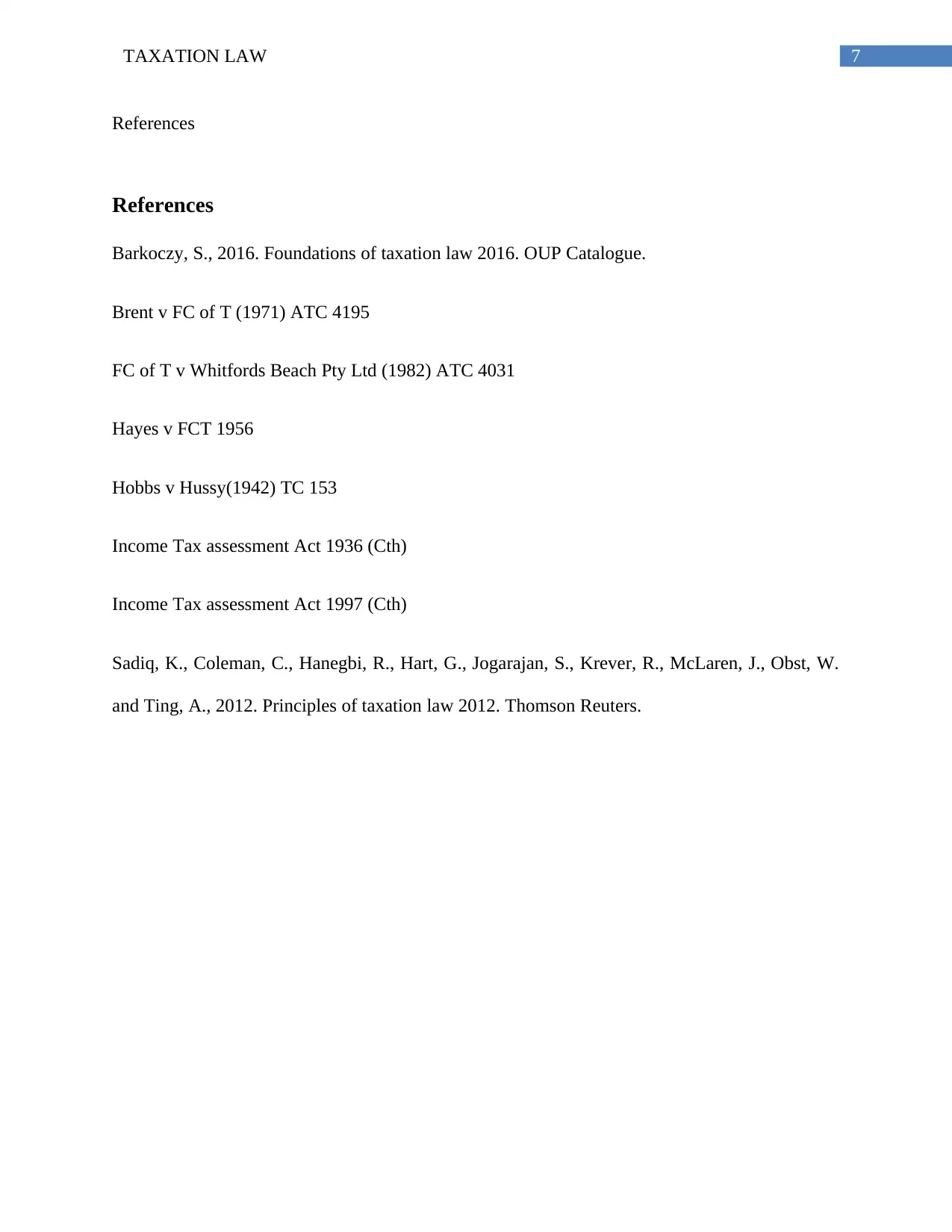
7TAXATION LAW
References
References
Barkoczy, S., 2016. Foundations of taxation law 2016. OUP Catalogue.
Brent v FC of T (1971) ATC 4195
FC of T v Whitfords Beach Pty Ltd (1982) ATC 4031
Hayes v FCT 1956
Hobbs v Hussy(1942) TC 153
Income Tax assessment Act 1936 (Cth)
Income Tax assessment Act 1997 (Cth)
Sadiq, K., Coleman, C., Hanegbi, R., Hart, G., Jogarajan, S., Krever, R., McLaren, J., Obst, W.
and Ting, A., 2012. Principles of taxation law 2012. Thomson Reuters.
References
References
Barkoczy, S., 2016. Foundations of taxation law 2016. OUP Catalogue.
Brent v FC of T (1971) ATC 4195
FC of T v Whitfords Beach Pty Ltd (1982) ATC 4031
Hayes v FCT 1956
Hobbs v Hussy(1942) TC 153
Income Tax assessment Act 1936 (Cth)
Income Tax assessment Act 1997 (Cth)
Sadiq, K., Coleman, C., Hanegbi, R., Hart, G., Jogarajan, S., Krever, R., McLaren, J., Obst, W.
and Ting, A., 2012. Principles of taxation law 2012. Thomson Reuters.
1 out of 8
Related Documents
Your All-in-One AI-Powered Toolkit for Academic Success.
+13062052269
info@desklib.com
Available 24*7 on WhatsApp / Email
![[object Object]](/_next/static/media/star-bottom.7253800d.svg)
Unlock your academic potential
Copyright © 2020–2025 A2Z Services. All Rights Reserved. Developed and managed by ZUCOL.





